


A bell pit is a primitive method of mining coal, iron ore, or other minerals lying near the surface.



A bell pit is a primitive method of mining coal, iron ore, or other minerals lying near the surface.
A shaft is sunk to reach the mineral which is excavated by miners, transported to the surface by a winch, and removed by means of a bucket, much like a well. [1] The bottom of the shaft is enlarged and a sloping roof is created as the desired mineral and surrounding rock is removed – giving its name because the pit in cross section resembles a bell. [2]
Typically, no supports were used, and mining continued outwards until the cavity became too dangerous or collapsed at which point another mine was started, often in close proximity. [1] This type of mine was in use in prehistoric times, the Middle Ages, [3] and a few continued in use until the early 20th century in the region around Ford, Northumberland. Such pits are common at prehistoric flint working sites such as Grime's Graves in Norfolk and also in the coal mining areas of Yorkshire, the Forest of Dean, [4] and Leicestershire. [3]
Bell pits often flooded due to a lack of a drainage system. This, together with the lack of support and the likelihood of collapse, meant they had a limited lifespan. The remains of bell pits can be identified by depressions left when they collapsed. In some places, they will follow a straight line as the seam of mineral is being followed. Bell pits were not an efficient way of extracting minerals as they only partially exploited the resources.

Mining is the extraction of valuable geological materials and minerals from the surface of the Earth. Mining is required to obtain most materials that cannot be grown through agricultural processes, or feasibly created artificially in a laboratory or factory. Ores recovered by mining include metals, coal, oil shale, gemstones, limestone, chalk, dimension stone, rock salt, potash, gravel, and clay. The ore must be a rock or mineral that contains valuable constituent, can be extracted or mined and sold for profit. Mining in a wider sense includes extraction of any non-renewable resource such as petroleum, natural gas, or even water.

Underground hard-rock mining refers to various underground mining techniques used to excavate "hard" minerals, usually those containing metals, such as ore containing gold, silver, iron, copper, zinc, nickel, tin, and lead. It also involves the same techniques used to excavate ores of gems, such as diamonds and rubies. Soft-rock mining refers to the excavation of softer minerals, such as salt, coal, and oil sands.

Coal mining is the process of extracting coal from the ground or from a mine. Coal is valued for its energy content and since the 1880s has been widely used to generate electricity. Steel and cement industries use coal as a fuel for extraction of iron from iron ore and for cement production. In the United Kingdom and South Africa, a coal mine and its structures are a colliery, a coal mine is called a "pit", and above-ground mining structures are referred to as a "pit head". In Australia, "colliery" generally refers to an underground coal mine.
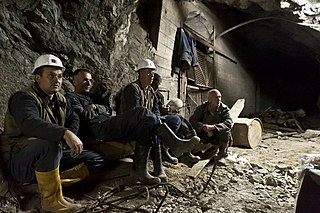
A miner is a person who extracts ore, coal, chalk, clay, or other minerals from the earth through mining. There are two senses in which the term is used. In its narrowest sense, a miner is someone who works at the rock face; cutting, blasting, or otherwise working and removing the rock. In a broader sense, a "miner" is anyone working within a mine, not just a worker at the rock face.
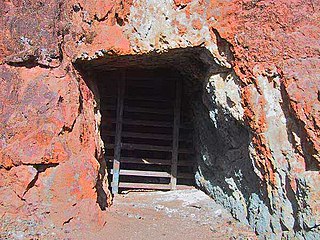
An adit or stulm is a horizontal or nearly horizontal passage to an underground mine. Miners can use adits for access, drainage, ventilation, and extracting minerals at the lowest convenient level. Adits are also used to explore for mineral veins. Although most strongly associated with mining, the term adit is sometimes also used in the context of underground excavation for non-mining purposes; for example, to refer to smaller underground passageways excavated for underground metro systems, to provide pedestrian access to stations, and for access required during construction.
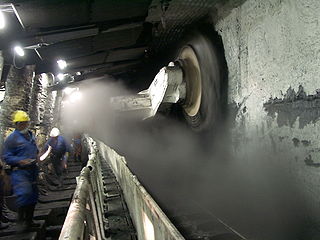
Longwall mining is a form of underground coal mining where a long wall of coal is mined in a single slice. The section of rock that is being mined, known as the longwall panel, is typically 3–4 km (1.9–2.5 mi) long, but can be up to 7.5 km (4.7 mi) long and 250–400 m (820–1,310 ft) wide. The longwall method compares with shortwall, room-and-pillar, and several others.

Surface mining, including strip mining, open-pit mining and mountaintop removal mining, is a broad category of mining in which soil and rock overlying the mineral deposit are removed, in contrast to underground mining, in which the overlying rock is left in place, and the mineral is removed through shafts or tunnels.
Drift mining is either the mining of an ore deposit by underground methods, or the working of coal seams accessed by adits driven into the surface outcrop of the coal bed. A drift mine is an underground mine in which the entry or access is above water level and generally on the slope of a hill, driven horizontally into the ore seam.
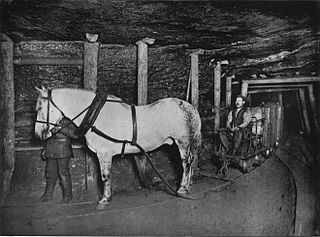
A pit pony, otherwise known as a mining horse, was a horse, pony or mule commonly used underground in mines from the mid-18th until the mid-20th century. The term "pony" was sometimes broadly applied to any equine working underground.

Mine exploration is a hobby in which people visit abandoned mines, quarries, and sometimes operational mines. Enthusiasts usually engage in such activities for the purpose of exploration and documentation, sometimes through the use of surveying and photography. In this respect, mine exploration might be considered a type of amateur industrial archaeology. In many ways, however, it is closer to caving, with many participants actively interested in exploring both mines and caves. Mine exploration typically requires equipment such as helmets, head lamps, Wellington boots, and climbing gear.

The following outline is provided as an overview of and topical guide to mining:

Chatterley Whitfield Colliery is a disused coal mine on the outskirts of Chell, Staffordshire in Stoke on Trent, England. It was the largest mine working the North Staffordshire Coalfield and was the first colliery in the UK to produce one million tons of saleable coal in a year.

Stoping is the process of extracting the desired ore or other mineral from an underground mine, leaving behind an open space known as a stope. Stoping is used when the country rock is sufficiently strong not to collapse into the stope, although in most cases artificial support is also provided.

Coal mining in the United Kingdom dates back to Roman times and occurred in many different parts of the country. Britain's coalfields are associated with Northumberland and Durham, North and South Wales, Yorkshire, the Scottish Central Belt, Lancashire, Cumbria, the East and West Midlands and Kent. After 1972, coal mining quickly collapsed and had practically disappeared by the 21st century. The consumption of coal—mostly for electricity—fell from 157 million tonnes in 1970 to just 587,000 tonnes in 2023. Employment in coal mines fell from a peak of 1,191,000 in 1920 to 695,000 in 1956, 247,000 in 1976, 44,000 in 1993, 2,000 in 2015, and to 360 in 2022.

The Forest of Dean Coalfield, underlying the Forest of Dean, in west Gloucestershire, is one of the smaller coalfields in the British Isles, although intensive mining during the 19th and 20th centuries has had enormous influence on the landscape, history, culture, and economy of the area.

Bradford Colliery was a coal mine in Bradford, Manchester, England. Although part of the Manchester Coalfield, the seams of the Bradford Coalfield correspond more closely to those of the Oldham Coalfield. The Bradford Coalfield is crossed by a number of fault lines, principally the Bradford Fault, which was reactivated by mining activity in the mid-1960s.
Coal mining played an important part in the history of the Black Country area immediately west of Birmingham, England. It was the basis for the area's industrial development in the nineteenth century; without coal there was insufficient power. Commentators spoke of the Black Country as a great coalfield, and of the earth turned inside out by all the mining activity. Most of the mines were not large scale, but small rough and ready pits similar to the Racecourse Colliery exhibit at the Black Country Living Museum. There were as many as five or six hundred small pits like this exploiting the seams of the South Staffordshire coalfield.
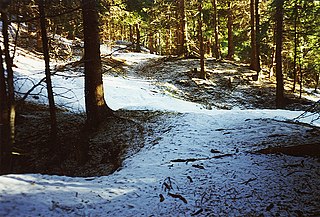
A Pinge or Binge ("binger") is the name given in German-speaking Europe to a wedge-, ditch- or funnel-shaped depression in the terrain caused by mining activity. This depression or sink-hole is frequently caused by the collapse of old underground mine workings that are close to the Earth's surface. Unlike natural landforms, a Pinge is a direct result of human activity. The term has no direct equivalent in English, but may be translated as "mining sink-hole", "mine slump" or, in some cases, as "glory hole".
This is a partial glossary of coal mining terminology commonly used in the coalfields of the United Kingdom. Some words were in use throughout the coalfields, some are historic and some are local to the different British coalfields.
Hapton Valley Colliery was a coal mine on the edge of Hapton near Burnley in Lancashire, England. Its first shafts were sunk in the early 1850s and it had a life of almost 130 years, surviving to be the last deep mine operating on the Burnley Coalfield.